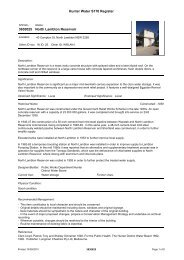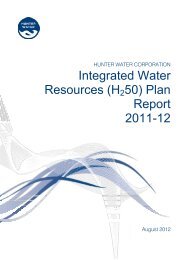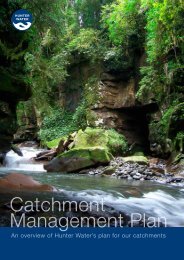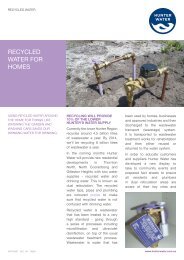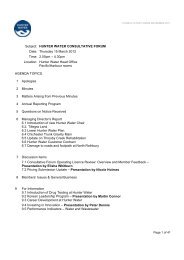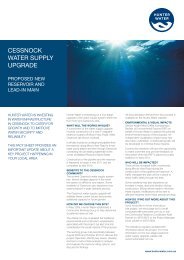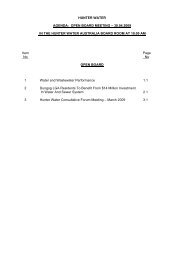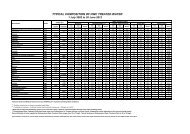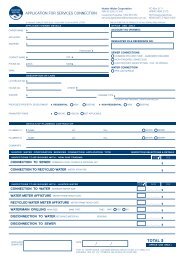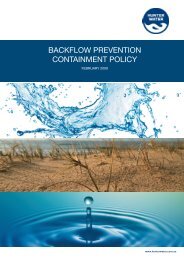Water Kit - Hunter Water
Water Kit - Hunter Water
Water Kit - Hunter Water
Create successful ePaper yourself
Turn your PDF publications into a flip-book with our unique Google optimized e-Paper software.
3.4 morpeth wastewater & wetlands<br />
Wastewater to wetlands<br />
The decommissioned treatment ponds<br />
at the old Morpeth WWTW have been<br />
transformed into a wetland sanctuary for<br />
local and migratory birds.<br />
The original WWTW was constructed in<br />
1940. During 2001 a new $20M treatment<br />
works was constructed to cater for<br />
population growth in the area and reduce<br />
nutrients entering local waterways.<br />
The old plant’s maturation ponds have been<br />
converted to wetlands<br />
The WWTW used a series of shallow<br />
ponds to allow direct sunlight to kill<br />
bacteria in the effluent. The new facility<br />
uses artificial ultraviolet light in a<br />
disinfection tank.<br />
During planning for the new treatment<br />
works, <strong>Hunter</strong> <strong>Water</strong> became aware<br />
that the old maturation ponds had<br />
An aerial photo of the new Morpeth WWTW<br />
and wetland sanctuary<br />
become habitat for local and migratory<br />
birds. With this knowledge <strong>Hunter</strong><br />
<strong>Water</strong> committed to retain the open<br />
water ponds and rehabilitate them as a<br />
wetland area for birds.<br />
The rehabilitation project<br />
Over 100 tonnes of concrete and soil<br />
waste were recycled on-site instead of<br />
being disposed to landfill. This recycling<br />
involved the creation of beaches, islands<br />
and shallow ponds to attract a variety of<br />
wading birds.<br />
The rehabilitated wetlands generated<br />
great interest among bird watchers<br />
and the local community. A team of<br />
environmental workers and <strong>Hunter</strong> <strong>Water</strong><br />
employees planted hundreds of native<br />
trees and shrubs around the wetland. The<br />
aim was to recreate a ‘natural’ wetland<br />
ecosystem.<br />
High quality treated effluent from the<br />
new plant is only pumped into the<br />
wetlands when natural water levels fall<br />
too low to sustain the ecosystem. This<br />
constant source of water has supported<br />
the survival of local and migratory birds<br />
during periods of drought.<br />
Treating wastewater at Morpeth<br />
Morpeth WWTW serves about 50,000<br />
people who live and work primarily in<br />
Morpeth, Metford, Thornton, Tenambit,<br />
Ashtonfield, Beresfield and East Maitland.<br />
The WWTW has the capacity to treat an<br />
average flow of 14 million litres per day,<br />
or about 60,000 people. The facitility has<br />
the capacity to be upgraded to serve<br />
80,000 people in the future - subject to<br />
planning approval.<br />
The new plant was built to minimise<br />
impacts on the surrounding environment.<br />
Wastewater is collected from houses and<br />
industry via pipes and pumping stations,<br />
and treated to a high standard that<br />
includes a disinfection stage.<br />
The final treated effluent is recycled where<br />
possible or otherwise discharged into<br />
the <strong>Hunter</strong> River. During dry conditions<br />
some effluent is diverted to the wetland<br />
ponds. Recycled wastewater is used to<br />
irrigate golf courses and woodlots. The<br />
remaining sludge (solids) is treated and<br />
dewatered to become biosolids, and<br />
reused in agricultural activities and mine<br />
rehabilitation on the site.<br />
Protecting the Lower <strong>Hunter</strong> catchment<br />
By 2006 all of <strong>Hunter</strong> <strong>Water</strong>’s WWTWs<br />
will have been completely upgraded.<br />
The focus of these upgrades, which in<br />
turn reduces negative impacts on local<br />
waterways where effluent is discharged.<br />
In achieving higher levels of treatment<br />
however, some trade-offs have had to be<br />
made, including:<br />
• higher costs for construction and<br />
operation of new plants compared<br />
to older plants<br />
• more atmospheric emissions from<br />
power stations associated with<br />
higher power usage at plants<br />
• increased transport needs through<br />
recycling greater quantities of<br />
biosolids<br />
A water quality report on the <strong>Hunter</strong><br />
River indicated that lowering nitrogen<br />
and phosphorus levels in effluent would<br />
protect and improve downstream water<br />
quality. Levels of nitrogen have been<br />
reduced from 15 to 7 milligrams and<br />
levels of phosphorus reduced from 6 to 3<br />
milligrams per litre.<br />
Reductions in phosphorus and nitrogen<br />
beyond this, however, were considered<br />
to be of little impact as Morpeth WWTW<br />
only contributes 2% to 3% of the total<br />
nutrient load in the river.<br />
<strong>Water</strong> kit . ssS . 001 . april 2010<br />
9




